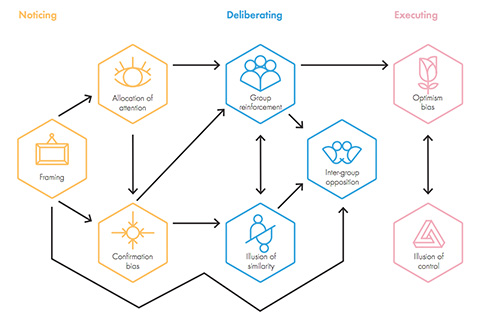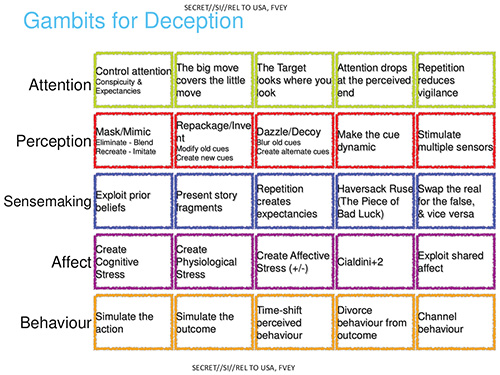 Submitted by Mad Max on
Submitted by Mad Max on

Corporate and state elites use information, money, law, and psychology in an effort to control your thoughts and behaviours for their own ends. Most of the psychological warfare documented in the book is a result of living in a fragmented, for-profit culture over which the individual has little control.
In case these unconscious structures fail to keep people in their place, the military, secret services, governments, and corporations have developed an impressive array of deliberate mind-control technologies and behavioural analysis firms targeted towards the individual.
Brain Chips
The US Central Intelligence Agency’s (CIA) mind control experiments, dating back to the 1950s, are well-known. Their MK-ULTRA experiments in sensory deprivation continue to be used on Guantánamo Bay captives. But until Ian Cobain’s book Cruel Britannia, few people knew that British psychologists had pioneered the use of sensory deprivation for mind control.
During WWII, Lord Swinton “pressed the Home Office for permission to open an MI5 interrogation centre,” codenamed Camp 020. Brightly lit for 24 hours, a resident doctor reportedly said that the Camp induced “mental atrophy and extreme loquacity” in its victims. A resident medical officer named Harold Dearden “dreamed up the regimes of starvation and of sleep and sensory deprivation.” The Camp was one of a number, including the MI19-run Combined Services Detailed Interrogation Centre, later renamed A19.
After the War, several individuals convened to share intelligence on mind control. They represented the Defence Research Policy Committee, the Joint Intelligence Bureau, the Canadian Defence Research Board, the CIA’s Research and Development Board, and the Psychology Unit at McGill University (Montreal). The latter was led by Donald Hebb.
The scientists referred to their psychological devastation techniques as “menticide.” Hebb subjected terrier puppies to prolonged isolation before trying it on consenting postgraduate students. The British and American governments and the CIA funded Hebb’s successors, including his former student Dr Maitland Baldwin. Baldwin found “that sensory deprivation would almost certainly cause irreparable psychological damage” in humans.
The CIA’s Kubark Counterintelligence Interrogation Manual (1963) was based on MK-ULTRA. One of the MK-ULTRA psychiatrists was McGill University’s Dr Ewen Cameron, a colleague of Hebb. Cameron “subjected hundreds of psychiatric patients to large doses of electroshock and total sensory isolation, and drugged them with LSD and PCP,” writes journalist Naomi Klein. In 1960, Cameron lectured to the Brooks Air Force Base, stating that sensory deprivation “produces the primary symptoms of schizophrenia.”
Tulane University was allegedly involved in the operations, using the services of a state-hospital, as well as funding by a CIA front company called the Commonwealth Fund, to conduct research. The Washington Post reports that the “quest to turn humans into robot-like assassins via electrodes planted in their brains” led to a number of lawsuits, in which several ex-servicemen claim to have been unwitting human test subjects. Plaintiff Bruce Price claims that in 1966, he was ordered into a building full of lab animals in which he was strapped to a gurney. Price kept waking up with bruised arms and covered in blood. A later CT scan, obtained by Price’s lawyer, appears to show that he had been implanted with a mind control device.
Beyond Freedom & Dignity
In the 1950s, the psychologist B.F. Skinner utilised the Russian (and later Soviet) scientist Ivan Pavlov’s conditioning techniques to falsely argue that that is how human beings learn. Geneticists pointed out that the potential for knowledge actually comes from innate brain structures, not solely from repetitive learning. But Skinner was correct in that people can be conditioned, if the conditioning is maintained, to behave in certain ways and under certain conditions.
Skinner’s work culminated in the publication of his book Beyond Freedom and Dignity (1971), in which he argued that humanity should be scientifically controlled via a blend of Orwellian and Huxleyan social architecture designed to end both human freedom and dignity.
Skinner failed to persuade elites to impose a blanket control system. But such a system is gradually creeping in, based on these kinds of ideas. In his work on “nudging,” Barack Obama’s former advisor Cass Sunstein argues that, like rats in a maze, people should be given the illusion of choice in what he and co-authors call choice architecture. Conspiracy forums should be “cognitively infiltrated,” he says, and the supposed rationalism of the official line inserted into chat-rooms. More ominously, he says behavioural science teams should be expanded to control public opinion, for benign reasons, like “nudging” smokers to quit. However, since Brexit in the UK and the British government’s response to coronavirus, we’ve seen the darker sides of “nudging” techniques.
Nudge Units
The Behavioural Insights Team (BIT) was founded by the UK’s Tory-Liberal coalition government in 2010. The Cabinet Office said: “The Behavioural Insights Team, often called the ‘Nudge Unit’, draws on insights from academic research in behavioural economics and psychology, to apply them to public policymaking.” The professed aims of the BIT may sound innocent enough: to use insights in human behaviour from the fields of neuroscience and cognitive psychology to influence behaviour (hence the “nudge”) in positive directions, such as helping people to eat more healthily, keep appointments, and pick up litter.

The first thing to be said about the BIT is the moral question of using subconscious ploys to consciously manipulate human behaviour. This takes away agency and thus autonomy from the individual. That is called manipulation. In fact, policymakers are so interested in the subject of how to use psychology, as opposed to force, to control people that there is even The Persuasion Handbook (2002, SAGE).
The second issue is consent. In clinical and psychological trials, the consent of the subject is required. Who consents to be manipulated by the government? But putting aside the moral issues, the third problem is that of context.
The government only cares about your health when it affects government spending. As it defunds and privatises, the British government doesn’t want people draining the National Health Service with smoking- and obesity-related complaints. It is cheaper to use manipulation techniques as a kind of preventative medicine than it is to properly fund services that everyone can enjoy. The same applies to the British government’s handling of COVID-19. Rather than spending money on testing, tracking, and tracing, the government used “nudge” units to contain the virus on the cheap by social distancing and clapping every Thursday at 8pm for the National Health Service.
The fourth problem with the BIT is mission creep. As is standard practice in our Western kleptocracies, the public paid for the foundation and research of the BIT until it was profitable enough to be part-privatised. The BIT now operates in several countries and produces reports on everything from policing to labour productivity; all in the interests of humanity, of course.
Joint Threat Research Intelligence Group
By 2010, the British government’s spy agency, GCHQ and the US agency the NSA, were working together on JTRIG: the Joint Threat Research Intelligence Group. The organisation was secret until Edward Snowden leaked some of the organisation’s files. Many of the files were published by the journalist Glenn Greenwald in The Intercept. One document from 2011 is worth quoting at length. It says that “JTRIG targets a range of individual, group and state actors across the globe who pose criminal, security and defence threats.” JTRIG operations also targeted the online “hacktivist” group Anonymous.
“JTRIG staff use a range of techniques to, for example, discredit, disrupt, delay, deny, degrade, and deter.” Both established and up-and-coming political analysts, journalists, pundits, personalities and other influential people who challenge the British state may find their websites and social media accounts hacked or incriminating evidence planted on their computers.

The techniques include: uploading YouTube videos containing persuasive messages; establishing online aliases with Facebook and Twitter accounts, blogs and forum memberships for conducting HUMINT [human intelligence] or encouraging discussion on specific issues; sending spoof emails and text messages as well as providing spoof online resources; and setting up spoof trade sites.
The document goes on to note that “JTRIG provides most of GCHQ’s cyber effects and online HUMINT capability.” GCHQ’s mandate is huge: the whole of Europe, and likely well beyond. It is difficult, therefore, to grasp the potential scope of JTRIG. Above, we noted the civilian government’s use of behavioural science to manipulate society. The JTRIG documents confirm that operatives also study and employ techniques from the human sciences:
HUMINT operations can be grounded in scientific theory and evidence from social psychology (i.e., social cognition, attitudes, persuasive communications, conformity, obedience, interpersonal relationships, trust and distrust, and psychological profiling), including its applications to advertising and marketing, and from criminology (i.e., crime prevention).
The document’s Annex reveals some of the books in the JTRIG library: The Handbook of Trust Research, Influence: Science and Practice, Hacking the Human: Social Engineering Techniques and Security and Countermeasures. JTRIG lists as, and advises using, the following for propaganda operations: “Using stereotypes; Substituting names/labels for neutral ones; Censorship or systematic selection of information; Repetition; Assertions without arguments; [and] Presenting a message for and against a subject.”
Meet the Artificial You
The Boston Globe reports that the US communications giant Verizon has a Wireless Precision Markets Insights programme that combines GPS, user app downloads and visited webpages to market products to individuals. Yves-Alexandre de Montjoye, a mathematician at MIT’s Media Laboratory, “hopes it will be possible someday to run psychological tests on entire cities or countries, simply by analysing the citizens’ phone records.” The newspaper goes on to explain how the Media Lab’s co-developed Sense Networks use cell phone GPS trails “to track where users go in daily routines – to the supermarket, the mall, nightclubs, museums, or movie theatres.” The programme “aggregates the data to create customized market segments” for people keen on music, sports, etc. Media Lab’s Nathan Eagle says that by studying cell phone records, analysts “get a real-time lens into how the aggregate population is actually behaving… That’s useful for anything from urban planning to public health.”
We come full circle with Sentient World Simulation (SWS), a programme that pools all the intelligence collected about you. SWS uses that information to simulate and predict how you would behave under certain social conditions, such as civil unrest, economic shocks or environmental catastrophe.
But it goes much deeper. The SWS was developed with military money at Purdue University. It creates a digital mirror-image of the real world, including you and me: our streets, towns and even the weather. In order to anticipate how we would react in real life, programmers do things to the digital us: cut our power supplies, simulate weather disasters, crash the economy, etc. This is useful for counterinsurgency planning and market prediction.
Technology researcher Mark Baard writes that the US Joint Forces Command (JFCOM-J9) is “capable of running real-time simulations for up to 62 nations, including Iraq, Afghanistan, and China. The simulations gobble up breaking news, census data, economic indicators, and climactic events in the real world, along with proprietary information such as military intelligence.” Based on the behavioural economics theories of Daniel Kahneman, SWS enables “Military and intel officials [to] introduce fictitious agents into the simulations (such as a spike in unemployment, for example) to gauge their destabilising effects on a population.”
Solutions: Getting Back to Nature
Self-empowerment is key to winning the psychological war.
Modern socio-economic systems isolate humans, simultaneously forcing us to compete. But humans evolved in cooperative, social networks, not within our current, curious blend of isolation and competition.
Researchers Apicella et al. studied the behaviours of Tanzanian Hadza, one of the few surviving hunter-gatherer peoples. They conclude that human social cooperation probably stems from similar societies that existed at the beginning of our species. Contrary to the anti-“communist” propaganda positing that communism and socialism encourage laziness, communal societies like the Hadza enjoy mutual reciprocity. Researchers Shirado et al. note that in such societies, “humans are influenced to cooperate by peer pressure.” So-called capitalist propaganda tries to deny us our instinct for cooperation and self-determination. Likewise, dictatorships like Mao’s and Stalin’s used the appeal of authentic communism to justify their centralised tyrannies.
Living in worker and community cooperatives is one solution to the crisis of social loneliness. Umberson and Montez write: “Social isolation of otherwise healthy, well-functioning individuals eventually results in psychological and physical disintegration, and even death.” They add that “social scientists have gone beyond evidence of extreme social deprivation to demonstrate a clear link between social relationships and health in the general population.” The authors note that, on average, people with better social networks tend to live healthier and longer lives than their relatively isolated counterparts.
Life in so-called primitive societies necessitates time outdoors: growing, hunting, and foraging for food; building and maintaining shelter; travelling to trade with neighbours; and travelling to and from homes and community centres for meetings. Researchers Coon et al. note the “promising effects on self-reported mental wellbeing immediately following exercise in nature which are not seen following the same exercise indoors.”
Briki and Majed exposed participants to different virtual reality backgrounds, including red, white and green during exercise in laboratory conditions. The authors attributed enhanced wellbeing, particularly increased relaxation, to the green virtual environment. In terms of real-world benefits, think of how little green exists in our concrete jungles.
It’s not just being outside that helps the mind. The physical interaction with natural objects is important. Gladwell et al. note: “people’s connectedness to nature appears to be changing and this has important implications as to how humans are now interacting with nature.” They add that “[b]arriers exist, and it is important that these are considered when discussing how to make exercise in the outdoors accessible and beneficial for all.”
Conclusion: The Joy of Self-Reliance
The self-sufficiency of stitching, building, maintaining and growing shelter, clothing and food is also psychologically beneficial. Part of today’s widespread mental malaise can be traced to the lack of process. We buy clothes that have already been made. Purchased food has been grown, picked, packaged and delivered by others. We buy or rent prefabricated houses and pay handypeople to maintain them. Dr Kelly Lambert “found that hands-on work satisfies our primal need to make things and could also be an antidote for our cultural malaise.” Psychology Today notes that “[t]oo much time on technological devices and the fact that we buy almost all of what we need rather than having to make it has deprived us of processes that provide pleasure, meaning and pride.”
In addition to its structures, the activities of the sovereign community benefit the human mind and enhance affective wellbeing. Our modern, urbanised living takes us ever further from nature. But human-environmental interactions are important for wellbeing. For example, land reform gives people the chance to grow their own food. Researchers Leake et al. cite the “[c]ompelling evidence of major health benefits of fruit and vegetable consumption, physical activity, and outdoor interaction with ‘greenspace’” that has emerged since the millennium. The physiological benefits include improved cardiovascular function, reduced osteoporosis, increased muscle tones, and exposure to light. Nutritional benefits from the kind of brassicas easy to grow independently (e.g., broccoli, cabbage, cauliflower and kale), include folic and ascorbic acids and cancer preventing nutrients. The mental health benefits of communal gardening include increased serotonin from sunlight exposure, which helps reduce depression; feelings of achievement; self-sufficiency; and integrating into a community and social network.
A more recent meta-analysis confirms: “gardening increases individual’s life satisfaction, vigour, psychological wellbeing, positive affect, sense of community, and cognitive function.” It is called “horticultural therapy.”
Dr. Tim Coles
© Copyright New Dawn Magazine, www.newdawnmagazine.com. Permission granted to freely distribute this article for non-commercial purposes if unedited and copied in full, including this notice.
© Copyright New Dawn Magazine, www.newdawnmagazine.com. Permission to re-send, post and place on web sites for non-commercial purposes, and if shown only in its entirety with no changes or additions. This notice must accompany all re-posting.
- 598 reads